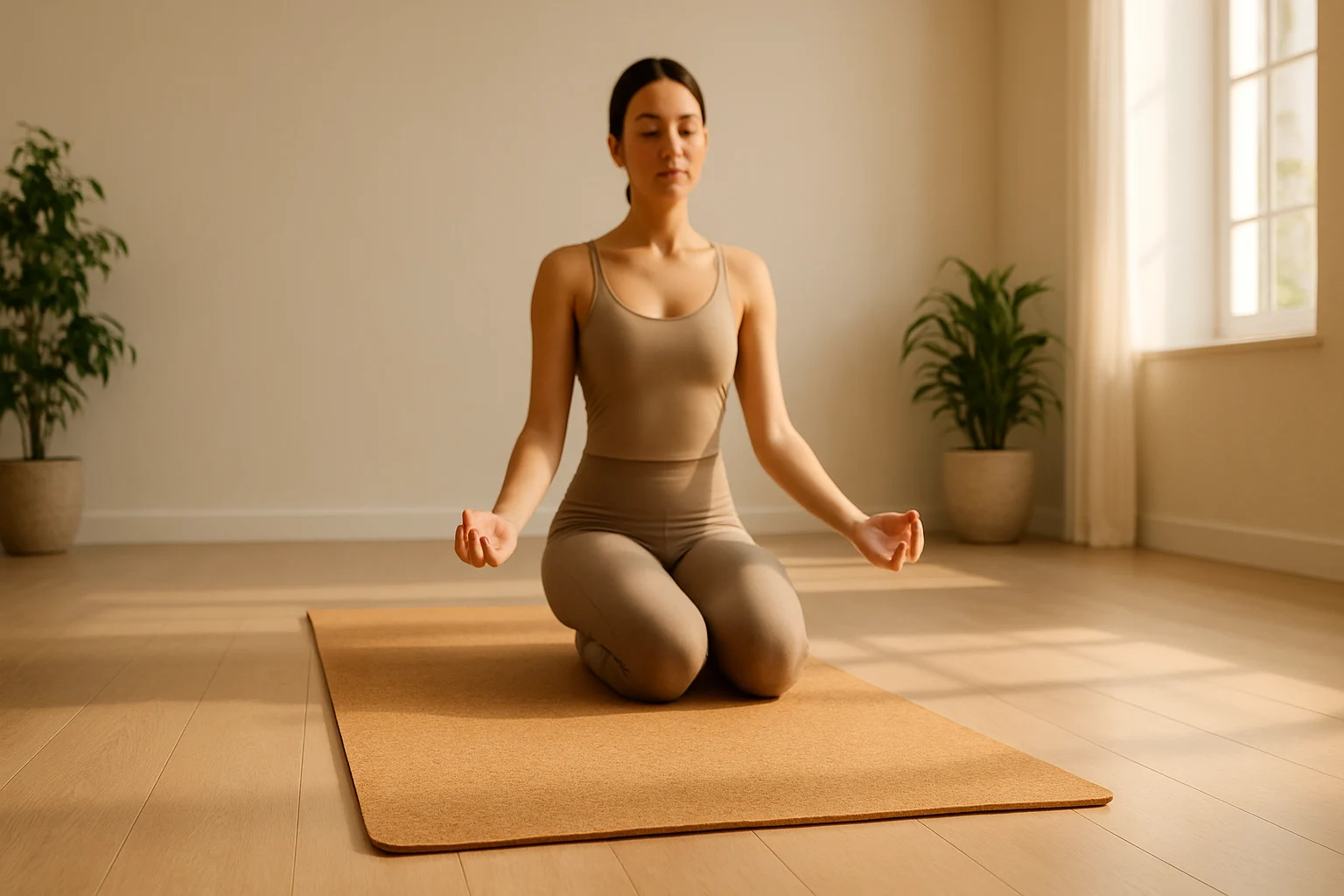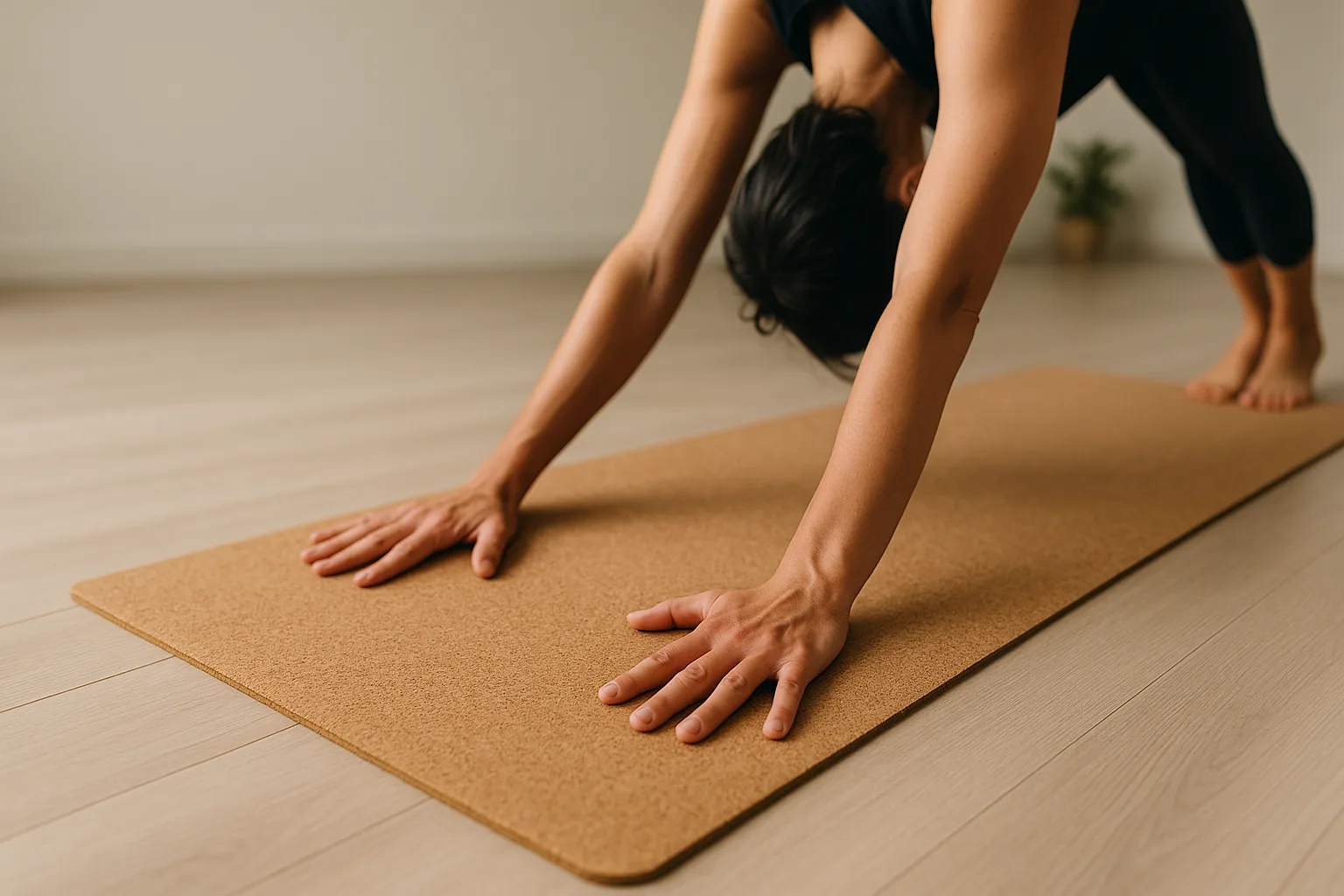
I used to dread class when my old mat left my forearms blotchy and itchy. A mat should feel like a little sanctuary—not set off sneezes or rashes. If you’ve got sensitive skin, a hypoallergenic yoga mat can make a real difference, giving you an allergy-friendly surface without the harsh extras. If you’re putting a kit together, our yoga gear guide walks through the essentials. Some mats use PVC or latex, which can bother certain people.
This guide shares my journey to find the best hypoallergenic yoga mats for a healthier practice. Cork’s naturally odor-resistant surface and rubber’s steady grip improved my sessions. I’ll cover materials, tips, and care hacks to help you flow freely.
Find Your Perfect Mat!This page contains paid/affiliate links. As an Amazon Associate we earn from qualifying purchases, and we may earn commissions from other partners—at no extra cost to you. Links marked with ‘#ad’ are affiliate links, meaning we may earn a commission at no extra cost to you. Learn more.
Table of Contents
Advantages of a Hypoallergenic Yoga Mat
Why I Love These Mats:
- Far less irritation—my skin stays calmer with latex- and PVC-free materials.
- I love how cork and natural rubber mats support the planet’s health.
- The grip and cushioning match my Vinyasa flow perfectly.
- Easy cleaning helps keep my mat fresh and low in allergens.
- I focus better without worrying about odors or itchiness. 🧘♀️

Why Choose a Hypoallergenic Yoga Mat?
Your mat is the spot where you breathe and move. If it makes you itch, it’s hard to focus on anything else. When I switched to an allergy-safe mat, the irritation dropped and my practice felt lighter; I could pay attention to breath again and feel good about the materials, too. If you want a calmer mindset on the mat, try these mindfulness techniques for stress relief.
Reduced Skin and Allergy Reactions
Some inexpensive PVC mats can contain additives (like certain plasticizers) that bothered my skin. As the AAAAI notes, latex allergy is more common in people with frequent exposure to latex products (for example, some healthcare workers). These materials may contribute to:
- Rashes: Red patches from contact were my yoga nemesis.
- Itching: It threw off my focus mid-pose.
- Breathing/odor issues: Off-gassing VOCs can be noticeable and may contribute to headaches for some people (including me). 😷
An allergy-friendly mat helps keep my sessions comfortable.
At-Home Inflammation Test
Curious what’s driving flare-ups? A simple at-home test can give you a baseline to discuss with your clinician.
Check availability Partnered
Not medical advice; talk to a healthcare professional for personal guidance.
Eco-Friendly and Sustainable
I moved to renewable cork and rubber—they feel solid under my hands and sit right with my values. If you want to bring that mindset into class, explore sustainable yoga practices:
- Biodegradability: Some materials can break down more readily under the right conditions.
- Cleaner Production: Formulations often use fewer additives, which may reduce emissions.
- Responsible Sourcing: Can support sustainable harvesting and workers. 🌍
Enhanced Comfort and Focus
A non-allergenic mat gives me peace of mind. Cork gets grippier when I sweat in hot yoga, and rubber keeps me steady in balances. I can finally sink into my practice without distractions.
Your mat should lift you up, not bring you down with itchiness!
Yoga Mat Materials and Allergy Risks
Before choosing a non-allergenic mat, I learned why some materials were wrecking my practice.
Why PVC Mats Are Problematic
My old PVC mat was grippy but, for me, the off-gassing odor felt unpleasant, so I switched to materials that may be gentler for sensitive skin. ☢️
TPE: A Partial Fix
I tried TPE mats, which skip latex and PVC and feel eco-friendly. But they’re synthetic, less sustainable, and once caused a mild rash for me.
Allergens to Steer Clear Of
My non-toxic yoga mat avoids these troublemakers:
- Latex: Latex was a nightmare for my allergies until I found latex-free rubber.
- PVC/Phthalates: These ingredients seemed to irritate my skin during sessions.
- Dyes: Some may contain trace metals—if you’re sensitive, look for certified dyes.
- Azo Dyes: Synthetic dyes that sparked my sensitivity.
- Formaldehyde: Occasionally reported in some products; I avoid it when possible.
Best Low-Irritant Mat Materials
These materials saved my practice, keeping it safe and sustainable. For additional support in your practice, consider using essential yoga props like blocks and straps.
1. Natural Rubber
From rubber tree sap, natural rubber offers excellent grip and cushioning. Latex note: if you have a latex allergy, either skip rubber entirely or choose a mat that is clearly advertised as latex-free.
Pros
- Amazing grip
- Earth-leaning
- Durable 🌳
Cons
- Latex risk
- Bit heavy
- Slight smell at first
Care: I wipe it with mild soap and air dry away from sunlight.
2. Cork
Cork, harvested from oak bark, is naturally moisture-resistant and many people find it stays fresh between sessions.
Pros
- Naturally moisture-resistant; many people find it stays fresh
- Grippier when wet
- Super light ✨
Cons
- Less padding
- Might chip over time
Care: Just water and air dry—easy!
3. Organic Cotton or Jute
These soft, breathable options work well for gentler flows and slower practice.
- Cotton: Easy to toss in the wash and generally a low-fuss choice.
- Jute: Has a natural texture that feels grippy without being sticky.
Heads-up: They don’t offer as much traction or cushion as rubber. Care: Spot clean between washes and follow the label when laundering.
4. High-Quality TPE or PU Blends
Some TPE or PU-rubber blends are marketed as low-VOC. If that matters to you, skim the product page or certification notes for the exact model you’re considering.
Pros: Light and grippy. Cons: Not as planet-friendly. Care: Wipe gently.

Choosing Your Non-Toxic Yoga Mat
Your perfect non-allergenic mat depends on how you practice. Here’s what I consider.
Grip on an Eco-Friendly Yoga Mat
Cork shines in sweaty hot yoga sessions, while rubber’s traction is my go-to for Ashtanga. Restorative flows love thicker mats for comfort. For specific poses to enhance your practice, try gentle yoga sequences for flexibility.
Cushioning and Support
I pick 4–6mm for balance, 6–8mm for joint support, or 1–3mm for travel, though they’re less cushy.
Durability and Portability
I’ve had my rubber and cork mats for years; the cork rolls up light for class, while the rubber lives at home.
Easy Cleaning for Allergy Safety
After practice I wipe it with water or a drop of mild soap, then hang it to dry; it cuts down on moisture and keeps the space feeling fresh. Prefer unscented cleaners if you’re sensitive to fragrance, or dilute a gentle soap.
Guide to Selecting Your Yoga Mat
Find Your Perfect Hypoallergenic Yoga Mat 🧘
Choose your material and yoga style in two simple steps to discover the ideal mat for your practice.
Step 1: Choose Your Material
Step 2: Choose Your Yoga Style
Tips for Irritation-Free Yoga Practice
Beyond using a non-toxic yoga mat, a few simple habits help me avoid flare-ups:
- Natural clothing: I reach for organic cotton leggings; synthetics sometimes make my skin grumpy.
- Clean space: A quick dust and wipe with gentle cleaners keeps the nook tidy.
- Ventilate: Cracking a window helps clear any lingering odors.
- Hygiene: A fast wash of hands and feet before I start has become a calming ritual.
- Unscented products: I stick with fragrance-free so I’m not sneezing mid-flow.
Helpful tools for an irritation-free practice
Small tweaks can make your practice feel calmer—especially if joints or scents distract you.
| Tool | Why it helps | Shop |
|---|---|---|
| Heathyoga Knee Pad | Slim cushion for kneeling comfort in Camel or Low Lunge without changing how your mat feels. | Buy on Amazon |
| Cork yoga blocks (2-pack) | Dense, low-odor support for alignment and restorative poses. | Buy on Amazon |
| Mat cleaner (prefer unscented) | Quick spray-and-wipe keeps surfaces fresh without heavy fragrance. | Buy on Amazon |
Real Stories: Switching to Hypoallergenic Mats
Sarah’s eczema win: A longtime Vinyasa fan, Sarah struggled with wrist flare-ups. After moving to a Jade Harmony rubber mat, the irritation eased and her sessions felt steadier.
Mark’s clear breaths: In hot yoga, Mark kept noticing the odor from his old PVC mat. Swapping to a cork mat made the room feel cleaner and let him focus on breath again.
Top 3 Hypoallergenic Yoga Mats
Top 3Clean-feel materials and steady traction—pick based on how you practice.
Premium Cork Yoga Mat — 5mm
Naturally fresh surface that grips better as you sweat—great for heated classes and anyone sensitive to smells.
- Best for: Hot/Vinyasa, sweaty sessions
- Format: Cork top • Rubber base • ~5mm
Manduka eKO — Natural Rubber, 5mm
Sticky traction for dynamic flows with a natural next-to-skin feel.
- Best for: Ashtanga/flow
- Format: Natural rubber • ~5mm
ORW | OREN’S — PU Grip Top, 4mm
Smooth feel with serious grip when the heat turns up; easy maintenance between classes.
- Best for: Hot yoga / sculpt
- Format: PU top • Rubber base • ~4mm
Frequently Asked Questions
Conclusion
An eco-friendly yoga mat is my key to a healthier, happier practice. Whether it’s cork’s moisture- and odor-resistant charm or rubber’s reliable grip, these mats can help minimize irritants while being kind to the planet. Consider grip, cushioning, and certifications to find your match. Start your allergy-safe yoga journey today—flow freely and breathe easy! ✨


